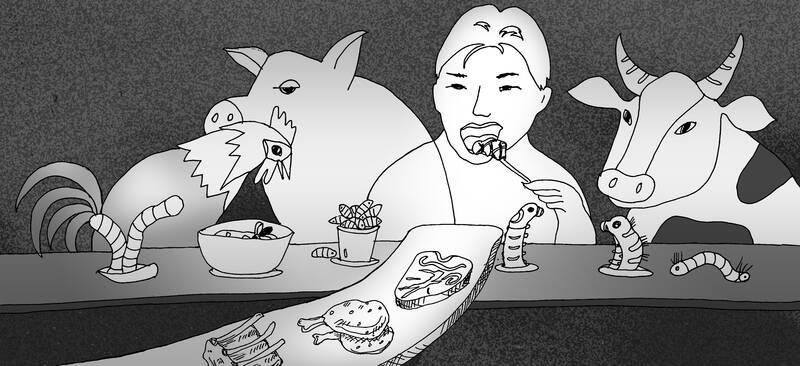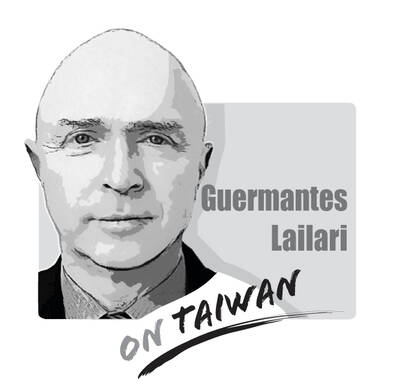No dystopian picture of a climate-ruined planet is complete until you have been put off your lunch.
Whether it is the grubs farmed by Dave Bautista in Blade Runner: 2049 or Charlton Heston in Soylent Green yelling that food is being made from “people,” there are few things that provoke as visceral a reaction as the prospect that ecological disaster might force you to eat something gross.
It Is hardly surprising, then, if we are regularly promised a future of Blade Runner-style protein farms, where insect larvae are bred en masse for human consumption. “STOP insect flour-based foods in school canteens,” Italian deputy Prime Minister Matteo Salvini wrote in an X posting last month, echoing a trope that has found currency among the country’s farm protestors.

Illustration: Tania Chou
Not everyone sees this future as a grim one — indeed, for some, it looks more like a utopia. Insects are highly efficient at converting waste matter into high-quality protein, making their consumption a potentially more sustainable way to feed a planet approaching 10 billion people.
New York-based chef Joseph Yoon promotes entomophagy with gourmet dishes such as scorpion rice balls and ant guacamole, while The Economist has been pushing the virtues of bugmeat for so long that it is starting to look like a running joke. “Edible insects can play a vital role in the global food system,” said the authors of a paper last week in Scientific Reports, compiling a list of 2,205 insect species eaten across the world.
The more realistic picture of the future is neither dystopia nor utopia, however — and it is not going to lead to us eating less chicken, pork and beef, either. If anything, the most likely future for insect farming is one where it accelerates humanity’s growing appetite for poultry and mammal flesh, rather than reducing it.
That is because insects are best suited to solving a problem the livestock industry has been struggling with for decades — the protein deficit. Intensive farming depends on getting animals to grow faster, and that requires levels of protein that are rarely found in their natural diets.
Soybeans are not a top-four global crop because of all the edamame, tofu and dairy-free lattes we consume, but because the soymeal left over after oil is squeezed out is about half protein, making it an excellent additive to animal feed. Such protein-rich feed cakes are also one of the main byproducts of the corn ethanol industry.
That is not the half of it. Indeed, a history of the things used to bulk up livestock over the years provides enough horror stories to fill a Black Mirror season.
Chicken manure is a routine high-protein feed ingredient in much of the world, including the US. So is fishmeal, made from rendering fish too small for human consumption into powder. There have even been multiple stomach-churning experiments looking at whether cattle could be fed with their own dung.
Indeed, insect farming would be having a much easier time of things right now if previous attempts to solve the protein deficit had not led to disaster. Bovine spongiform encephalopathy, the brain-wasting condition known as mad-cow disease, appears to have emerged in the UK in the 1980s because cattle were being fed meat and bone meal, another protein-rich feed enhancer. That infected them with scrapie, a degenerative disease present in the brain tissue of the sheep being ground into meal. The resulting public-health emergency led to tighter regulation of the animal-feed chain, so these days the controls are almost as tight as those on human food.
It is the growing awareness of the climate impact of farming that is starting to change that, as well as provoking those protests in Italy and across Europe, many of which are in opposition to increased environmental regulation of agriculture. Emissions from livestock amount to about 3.5 billion metric tonnes a year, equivalent to total climate pollution from the EU and Canada put together. Better management of animal waste — such as feeding manure to insect larvae, which could then be turned into nutritious feed — could play a major role in reducing that burden.
Those hoping that human entomophagy will lead to more sustainable global food systems should be careful what they wish for: The ecologically minded push to include more grubs in human diets is going hand-in-hand with a more hard-headed drive to allow them back into feed troughs, too. The EU allowed insects to be fed to fish in 2017 and to chickens and pigs in 2021.
Horrible food is such a sci-fi staple because people are fussy eaters — one reason that insect farming so far is mostly serving the needs of grub-eating pets, as Bloomberg News reported last month. However, farm animals do not get a choice about their lunch.
If feed pellets made from fly larvae, crickets and mealworms succeed in lowering the cost of producing poultry and livestock meat, it is going to make such products more affordable and increase global consumption. That is unlikely to be a win in climate terms, no matter how efficiently we bulk up our farm animals.
If you are looking for a diet with a lower carbon footprint, you would be better off giving up meat altogether.
David Fickling is a Bloomberg Opinion columnist covering energy and commodities. Previously, he worked for Bloomberg News, the Wall Street Journal and the Financial Times. This column does not necessarily reflect the opinion of the editorial board or Bloomberg LP and its owners.

Chinese state-owned companies COSCO Shipping Corporation and China Merchants have a 30 percent stake in Kaohsiung Port’s Kao Ming Container Terminal (Terminal No. 6) and COSCO leases Berths 65 and 66. It is extremely dangerous to allow Chinese companies or state-owned companies to operate critical infrastructure. Deterrence theorists are familiar with the concepts of deterrence “by punishment” and “by denial.” Deterrence by punishment threatens an aggressor with prohibitive costs (like retaliation or sanctions) that outweigh the benefits of their action, while deterrence by denial aims to make an attack so difficult that it becomes pointless. Elbridge Colby, currently serving as the Under
The Ministry of the Interior on Thursday last week said it ordered Internet service providers to block access to Chinese social media platform Xiaohongshu (小紅書, also known as RedNote in English) for a year, citing security risks and more than 1,700 alleged fraud cases on the platform since last year. The order took effect immediately, abruptly affecting more than 3 million users in Taiwan, and sparked discussions among politicians, online influencers and the public. The platform is often described as China’s version of Instagram or Pinterest, combining visual social media with e-commerce, and its users are predominantly young urban women,
Most Hong Kongers ignored the elections for its Legislative Council (LegCo) in 2021 and did so once again on Sunday. Unlike in 2021, moderate democrats who pledged their allegiance to Beijing were absent from the ballots this year. The electoral system overhaul is apparent revenge by Beijing for the democracy movement. On Sunday, the Hong Kong “patriots-only” election of the LegCo had a record-low turnout in the five geographical constituencies, with only 1.3 million people casting their ballots on the only seats that most Hong Kongers are eligible to vote for. Blank and invalid votes were up 50 percent from the previous
Japanese Prime Minister Sanae Takaichi lit a fuse the moment she declared that trouble for Taiwan means trouble for Japan. Beijing roared, Tokyo braced and like a plot twist nobody expected that early in the story, US President Donald Trump suddenly picked up the phone to talk to her. For a man who normally prefers to keep Asia guessing, the move itself was striking. What followed was even more intriguing. No one outside the room knows the exact phrasing, the tone or the diplomatic eyebrow raises exchanged, but the broad takeaway circulating among people familiar with the call was this: Trump did